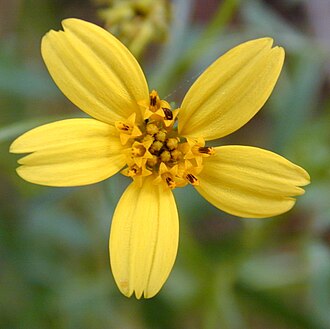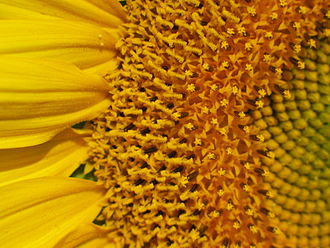(→Mint) |
|||
| Line 103: | Line 103: | ||
===Aster (Daisy)=== | ===Aster (Daisy)=== | ||
| + | [[Image:Bidens flwr.jpg|thumb|300px|A typical Asteraceae flower head (here Bidens torta) showing the individual flowers]] | ||
| + | [[Image:Flower head.jpg|thumb|300px|Flowers of a sunflower with different forms and phases (sterile ray flowers, disc flowers in female, male and unopened phases)]] | ||
| + | Plants in the Aster family typically have one or both of two kinds of florets. The outer perimeter of a flower head like that of a sunflower is composed of florets possessing a long strap-like petal, termed a ligule; these are the ray florets. The inner portion of the flower head (or disc) is composed of small flowers with tubular corollas; these are the disc florets. The composition of asteraceous inflorescences varies from all ray flowers (like dandelions, genus Taraxacum) to all disc flowers (like pineapple weeds). | ||
| + | * Aster | ||
| + | * Common Daisy | ||
| + | * Oxeye Daisy | ||
| + | * Black-eyed Susan | ||
| + | * Lettuce | ||
| + | * Chicory | ||
| + | * Sunflower | ||
| + | * Safflower | ||
| + | * Jerusalem Artichoke | ||
| + | * Goldenrod | ||
| + | * Chrysanthemum | ||
| + | * Dandelion | ||
| + | * Boneset | ||
| + | * Strawflower | ||
| + | * Ragwort | ||
| + | |||
| + | <br style="clear:both"> | ||
| + | |||
===Snapdragon=== | ===Snapdragon=== | ||
Revision as of 03:17, 1 August 2007
Lily
- Turk's Cap Lily
- Wild Garlic
- Onion
- Trillium
- Fawn Lily
- Tulip
- Hyacinth
Mustard
- Cabbage
- Broccoli
- Cauliflower
- Brussels sprouts
- Mustard
- Horseradish
- Watercress
Pink
- Swamp Milkweed
- Common Milkweed
- Butterfly Plant
- Sand Milkweed
- Whorled Milkweed
Buttercup
- Columbine
- Marsh Marigold
- Thimbleweed
- Clematis
- Hellbore
- Larkspur
- Buttercup
Cactus
- Saguaro
- Barrel Cactus
- Prickly Pear
- Rabbit Ear
Rose
Members of the Rose family have 5 sepals and 5 petals which are flat and wavy at the margins. Each flower has at least ten stamens. All members of the rose family have a hypanthium, which is a bowl-shaped part of a flower consisting of the bottoms of the sepals, petals, and stamens stuck together.
- Rose
- Apple
- Blackberry
- Strawberry
- Raspberry
- Apple
- Plum
- Peach
- Cherry
- Pear
Bean
All members of this family have five-petaled flowers in which the superior ovary ripens to form a "pod", technically called a legume, whose two sides split apart, releasing the seeds which are attached to one or both seams. A significant characteristic of legumes is that they host bacteria in their roots, within structures called root nodules. These bacteria have the ability to take nitrogen gas out of the air and convert it to a form of nitrogen that is usable to the host plant. This process is called nitrogen fixation.
- Bean
- Lupins
- Clover
- Alfalfa
- Peas
- Peanuts
- Soybeans
- Lentils
- Mimosa
- Kudzu
Parsley
The parsley family has flower clusters being in the form of a compound "umbel". The small flowers are radially symmetrical with 5 small sepals, 5 petals and 5 stamens.
- Cumin
- Parsley
- Carrot (Queen Anne's Lace)
- Dill
- Caraway
- Fennel
- Angelica
Smartweed
The seeds of the plants belonging to the smartweed family have a triangular shape. Leaves of these plants have a peculiar pair of sheathing stipules known as ocreae.
- Buckwheat
- Sorrel
- Rhubarb
- Knotgrass
Bellflower
The Bellflower family consists mostly of herbs, shrubs, and more rarely small trees, which usually have milky non-toxic sap. Leaves of these species are often alternate, more rarely opposite. They are also simple and without stipules. Flowers are bisexual, bell-shape, consisting of a narrow tube-like corolla with small spreading lobes. Flowers are fairly often blue. Fruits are often berries, but can also be capsules.
- Bluebell
- Harebell
- Lobelia
- Balloonflower
Mint
The flowers in the Mint family typically have petals fused into an upper lip and a lower lip. The leaves emerge oppositely, each pair at right angles to the previous one or whorled. The stems are frequently square in cross section, but this is not found in all members of the family, and is sometimes found in other plant families. The flowers are bilaterally symmetrical with 5 united petals, 5 united sepals. They are usually bisexual and have a flower cluster that looks like a whorl of flowers but actually consists of two crowded clusters.
- Basil
- Mint
- Rosemary
- Sage
- Savory
- Marjoram
- Oregano
- Thyme
- Lavender
- Perilla
- Self-heal
Aster (Daisy)
Plants in the Aster family typically have one or both of two kinds of florets. The outer perimeter of a flower head like that of a sunflower is composed of florets possessing a long strap-like petal, termed a ligule; these are the ray florets. The inner portion of the flower head (or disc) is composed of small flowers with tubular corollas; these are the disc florets. The composition of asteraceous inflorescences varies from all ray flowers (like dandelions, genus Taraxacum) to all disc flowers (like pineapple weeds).
- Aster
- Common Daisy
- Oxeye Daisy
- Black-eyed Susan
- Lettuce
- Chicory
- Sunflower
- Safflower
- Jerusalem Artichoke
- Goldenrod
- Chrysanthemum
- Dandelion
- Boneset
- Strawflower
- Ragwort



